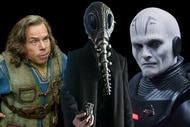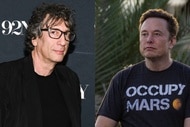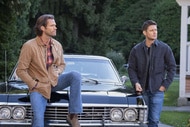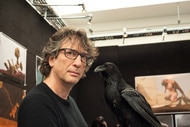Neil Gaiman and cast reveal the biggest Good Omens changes made for the TV series
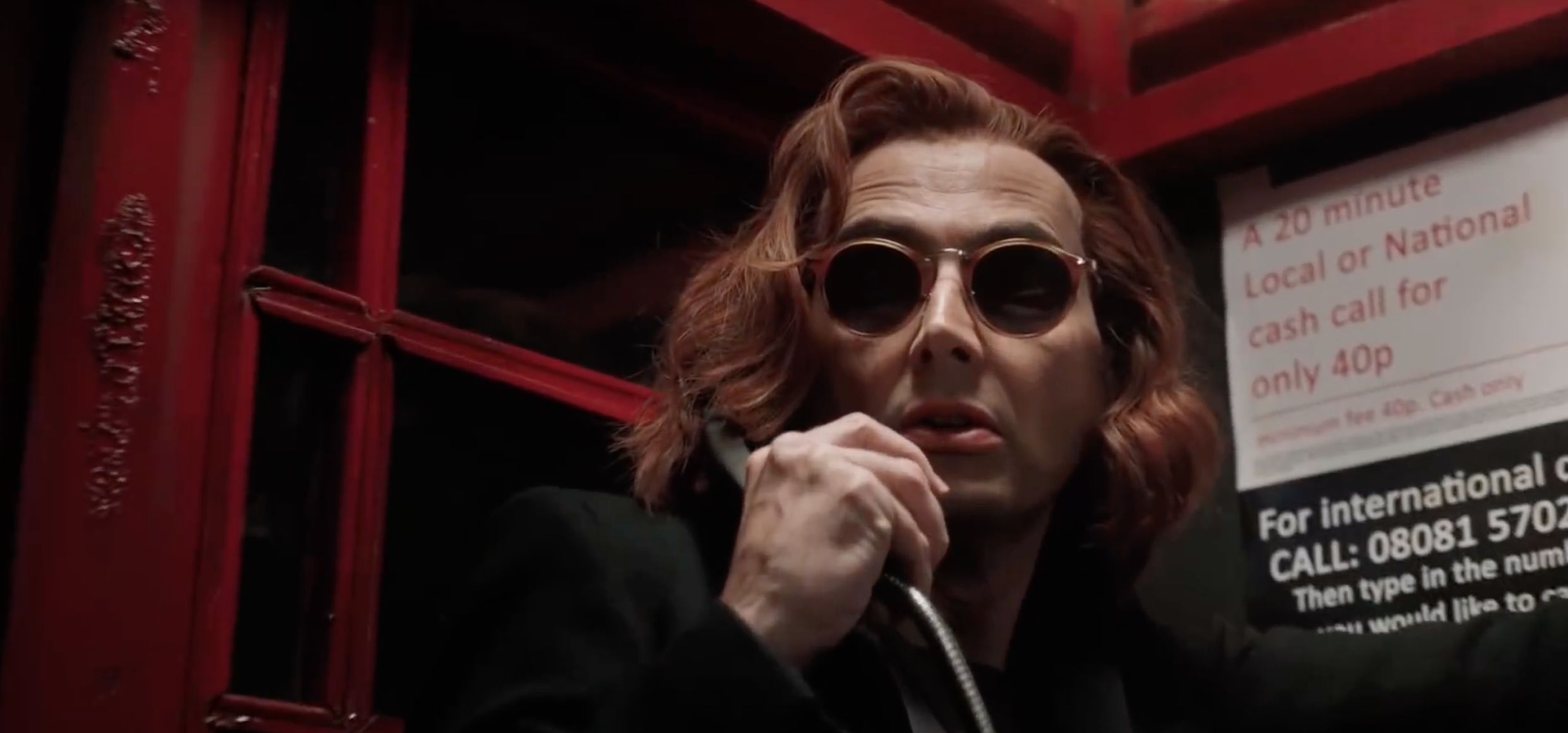
Being the author of a book and the showrunner of its TV adaptation definitely has its perks — you get to be the one to decide what to add or expand, what to shorten or lose altogether. For Neil Gaiman, adapting Good Omens, the book he co-wrote with the late Terry Pratchett, this meant a veritable playground, where he got to add characters and scenes discussed with Pratchett that weren’t in the original novel.
**SPOILER WARNING: There are plenty of spoilers ahead for Good Omens below.**
These new elements included the archangel Gabriel, as well as imagining a pre-credits sequence that followed the angel Aziraphale (Michael Sheen) and the demon Crowley (David Tennant) through 6,000 years of history. It also meant Gaiman had to make some tough calls about what to edit out, including a set of human bikers known as the other Four Horsepersons of the Apocalypse.
“For me, it’s a simple philosophy that I owe [Sherlock showrunner] Steven Moffat,” Gaiman told SYFY WIRE. “He told me, ‘When they make you cut things, and they will, always try to write a replacement scene that will become a YouTube clip. Make the scene that you do get to do a funnier one.’”
Below, Gaiman and some of the other show's creators break down some of the biggest changes during the adaptation process.
EPISODE 1
By the time Gaiman and director Douglas Mackinnon had finished cutting together Episode 1, it was about 75 minutes long, “which meant that we needed to lose 20 minutes,” Gaiman said. “And that 20 minutes was really hard to lose, because it was 20 minutes of beautiful material.”
Among those cut minutes was an extended scene of Crowley disabling the London mobile phone system, as he later reports to the demons in the graveyard during his evil deeds-of-the-day rundown.
“We built a huge set in South Africa for the BT Tower,” production manager Michael Ralph said. Crowley enters the lobby and tells the security guard he’s been sent from Rataway Pest Control to do a preliminary inspection. He’s taken up to the top floor, which is infested with hundreds of rats — rats summoned to do the demon’s bidding. (The rats were animated.) Crowley walks over to the computer room and tips tea from a thermos into the network controller, which makes the lights flicker and go out. Mission accomplished!
The scene then included people on the city streets experiencing the interruption in their mobile service at the worst possible moments (when they need to close a deal, arrange a pickup, or stave off a breakup), and Crowley walks away smiling. “We shot the whole thing, including helicopter arrivals to the BT Tower,” Ralph said. “There was a massive amount of work involved there,” cinematographer Gavin Finney agreed.
“What we wound up doing as our solution to bringing Episode 1 into focus was throwing out anything that was not directly part of the story,” Gaiman said. “We wound up with something that’s incredibly fast-moving and feels very full, but also runs just a hair over 50 minutes.”
The character of Archangel Gabriel, introduced in Episode 1, is also a show creation. "He's a major figure in biblical lore, but he was only briefly mentioned in the novel," said Jon Hamm, who plays Gabriel. "I knew that somewhere in the back of Neil's mind, this character had a much fuller existence than he did in the novel, and I'm glad that this is where we are, where we can flesh it out, and that I was able to be the person to do the fleshing."
EPISODE 2
One of the sequences shot for Episode 1 was cut, but survives in a montage in Episode 2 to introduce the Four Horsepersons of the Apocalypse. War spends her vacation time in a little African village, turning a peaceful place into a hellhole — mostly just by standing at the bar and slamming down beers while her presence inspires others to take up arms (and grenades ... and rocket launchers). Ralph built a shacklike bar out of corrugated metal with punched holes throughout it, so little pencil beams of light came through. “Visually, it was lovely,” Finney said. Other early moments with the rest of the Four Horsepersons — and the impact of their presence — were also trimmed.
One added scene that Gaiman was determined not be cut is the flashback of Agnes Nutter. It was an expensive scene, involving a large number of extras in period costumes, as well as pyrotechnics. But it was also a Pratchett scene, and when Gaiman consulted what he calls his celestial vision of his co-author, he imagined Pratchett saying a rude word to anyone who tried to chop it.
EPISODE 3
The most elaborate sequence — a 30-minute cold open — is not based on anything from the book per se. “It’s an exploration of the characters that [are] in the book in its heart,” Mackinnon said, “but it needed to be externalized. It needed to be shown.”
The trick was that it was rather expensive to cover about 6,000 years of history, with different looks and locations, and the production had to get creative to keep it viable. The spot in South Africa used for Noah’s ark in Mesopotamia in 3004 B.C. is the same location used for the crucifixion in Golgotha in 33 A.D. — just from a different angle. The crucifixes, Ralph noted, were the hardest part; he had to make them oversized so they would have an impact on camera, and he used a river of red cloth on the ground to suggest an abstract river of blood. Ancient Rome in 41 A.D. was built in the same studio later used to double for a dungeon during the French Revolution in 1793.
A location scout for the camp for the kids’ playground gave the production the idea of where to stage Arthurian Britain in 537 A.D. — a valley in Surrey where a castle turret was visible. “I thought, ‘Wouldn’t that be fantastic in the mist?’” Ralph said. “We didn’t need to build anything. We only needed to add the fog.”
“A ridiculous amount of fog,” Finney agreed. “We were just riffing on ideas from Excalibur and Monty Python there.”
The next period of history, Shakespearean London in 1601, brought a bit of luck — Good Omens got to be the first fictional production to shoot inside the Globe Theatre. The catch was that they could only shoot for five hours, which wasn’t enough time to manage a shoot with 500 extras in period costume. The solution? Turn a full Globe Theatre into an empty one, and make Shakespeare's play a flop. (“It’s funnier,” Gaiman said.)
Revolutionary France brought its own set of difficulties. Ralph researched how to make a working guillotine, and had the perfect spot to set it up – at the University of Cape Town, which was filled with architecture reminiscent of 1793 France. “I was going to build a platform and have hot water washing the blood down and steam coming up,” the production designer said. “But we ran out of time to do it before the university opened.” They came up with the solution to hear the guillotine outside a dungeon cell (built in the studio) instead.
Somewhere within this sequence — perhaps after Shakespearean England but before Revolutionary France — was supposed to be one more time capsule: Aziraphale opening his bookshop for the first time. Gabriel shows up to tell Aziraphale that he’s been promoted and can go back to Heaven, but Aziraphale doesn’t want to go. Crowley turns up with chocolate and flowers to congratulate Aziraphale, and overhears the conversation, so he instead turns around and sets up something where Aziraphale needs to intervene, to prove to Gabriel that Aziraphale’s appearance on earth is vital. “It was really funny,” Gaiman said. But his justification for taking it out was that it didn’t push the story forward as much as the other moments did.
EPISODE 5
When the Four Horsepersons of the Apocalypse assemble to ride, they attract a few human bikers in their wake — or at least they did in the original script. Four Hell’s Angels-worthy riders were cast as Pigbog, Greaser, Skuzz, and Big Ted, but their scenes were cut before the first read-through.
“I think I said, ‘I can’t do that and make it look great,’” Mackinnon said. The human bikers would have followed our supernatural bikers down the motorway, only to decide they need nightmares of their own to represent. Part of the humor derives from them not being able to make up their minds. Should they be Grievous Bodily Harm? Embarrassing Personal Problems? People Taking Selfies? Cruelty to Animals? Things Not Working Properly Even After You Thumped Them? No Alcohol Lager? Preoccupied, they miss an obstacle ahead of them and collide with an overturned fish lorry, and at least one of them becomes People Covered in Fish.
One other motorway effect that provided difficulty was Hastur the demon landing on Crowley’s car while it was moving and climbing into the car. “I was like, ‘That’s two days of filming,’” Mackinnon pointed out. So instead, they reached a compromise — Hastur would just appear in the car. “You can have some flashy things, but you can also just have a quite straightforward thing that just tells the story,” Mackinnon said. “And Neil embraced those compromises because he knew it was still the story.”
Good Omens Season 1 is available for viewing now on Amazon Prime.


